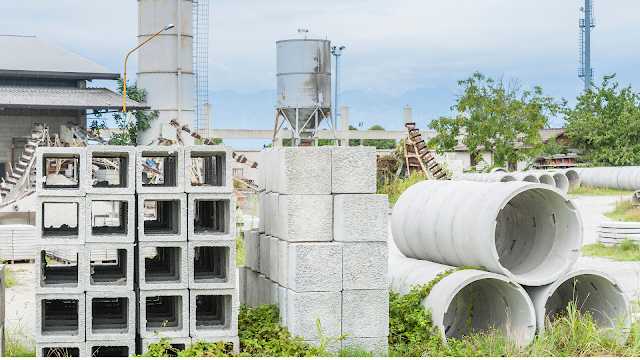With shifting global markets, increased customer expectations, and increasing labour costs, the precast concrete industry is constantly innovating. Productivity, quality, and bottom-line profits are always on the minds of producers. Additionally, the heightened awareness of environmental issues, coupled with a greater emphasis on project life-cycles, has meant more demand for environmentally friendly construction practices, especially regarding the reduction of waste, greenhouse gas emissions, and energy consumption.
It is no
surprise that concrete is one of the major construction materials and the most
abundant material produced around the world. This has driven the development of
new concrete technologies both in general and specifically for precastconcrete.
As a result, a
number of concrete types have been developed, including fibre reinforced
concrete, polymer concrete, Ferro cement, sulphur concrete, lightweight
aggregate concrete, autoclaved cellular concrete, high-density concrete,
ready-mixed concrete, self-compacting concrete, roller compacted concrete, high
strength concrete, super high-strength concrete, high-performance concrete,
high-volume fly ash concrete, self-curing concrete, floating concrete, and
smart concrete.
What are
concrete admixtures?
The purpose of
concrete admixtures is to improve certain properties of fresh or hardened
concrete, such as workability, durability, or early and final strength. These
can be natural or manufactured chemical additives added during concrete mixing
to enhance the above-mentioned properties.
Concrete
admixtures are no new discovery and have a history as old as the concrete or
concrete technology. The use of concrete admixture in mortar and concrete can
be traced back to Roman Empire, which is renowned for its elaborate
constructions and architecture.
The Romans
discovered that certain material allow greater workability in cementitious
mixtures. Thereby starting the tradition of mixing the admixtures into the
concrete before its use.
The recent times
however like every other technology has witnessed development and improvement
and so has the concrete technology. Now the concrete admixtures are used to enhance
the quality of concrete but also to make it suitable for different conditions.
Concrete
admixtures are now used to modify or improve the ordinary concrete properties
to benefit situations like mass concreting, concreting at narrow spaces etc.
They are also used at remote places where water is not available easily or
where there is a necessity of removing the formwork early, or for the concrete
work near coastal area, as such.
Chemical
admixtures and their importance
Chemical
admixtures are added to concrete to achieve or amplify its properties. The
admixtures are added typically immediately before or during the mixing process
to the concrete, in addition to cement, water and aggregate. As we understand
that different chemical admixtures have different capabilities and utility,
they are segmented in few categories.
Chemical
Admixtures are classified as:
·
Air Entertainers
Air entertainers
help in distributing tiny air bubbles in the concrete. These admixtures are
capable of reducing the bleeding and segregation of fresh concrete. Further
they are also capable of improving the resistance of concrete to severe frost
action consequently reducing the damage during freeze-thaw cycles. This in turn
increases the durability of concrete. Further these concrete admixtures also
help to reduce the density of concrete.
(b) Water
Reducers:
As the name
suggests the water reducer admixtures are added to reduce the quantity of
mixing water, required to produce concrete of a desired slump. These admixtures
are used to reduce water-cement ratio, reduce the cement content and increase
slump to obtain specific strength of concrete as needed in the projects.
·
Set Retarders:
The retarders
are admixtures that help in slowing down or delaying the chemical process of
hydration. The purpose of such requirement is to increase the time so that
concrete remains plastic and workable for a longer duration. These concrete
admixtures are widely used when the concrete mixtures have to be is carried out
at high temperature or to a different place from its mixing.
·
Set Accelerators:
Accelerators are
the opposite of the retarders and are added to concrete to increase the rate of
early strength in concrete. These admixtures permit earlier removal of formwork
and reduces the required period of curing. Among the admixtures of this
category the Calcium chloride is the most common accelerator. These categories
of concrete admixtures are especially advantageous for modifying the concrete
properties in cold weather.
·
Corrosion Inhibitors:
Corrosion inhibitors
are the admixtures used to reduce the corrosion in steel and steel bars in
concrete. These can reduce the maintenance cost of structure. Interestingly
they can reduce maintenance cost of RCC structures throughout a typical service
life of 30 to 40 years.
So to
summarise from above here is why admixtures are important in precast concrete:
·
It reduces water content in
concrete and maintains the water cement ratio as low as possible.
·
It increases the compressive
strength.
·
Enhances the durability
parameter of concrete
·
Aggravates the workability and
provides longer transportation and placing time.
·
To impart specific property of
concrete.
·
Creates favourable condition
during placing.
·
High quality admixtures are
capable of controlling the shrinkage cracks.
·
Ensures the quality of concrete
in adverse weather condition.
·
Modify the rate or capacity for
bleeding.
·
Improve pumpability and
decrease permeability
·
Increase bond between new
concrete and pre-existing if any.
Mapei
manufactures globally proven solutions and products for the demanding
production and repair of diverse precast concrete elements including
hollow-core planks, concrete pipes, burial vaults, septic tanks and double
tees, among others. As one of the global names and 85-year-old legacy Mapei
ensures but one thing the quality of product while providing variety to suit
the different site requirements.

Comments
Post a Comment